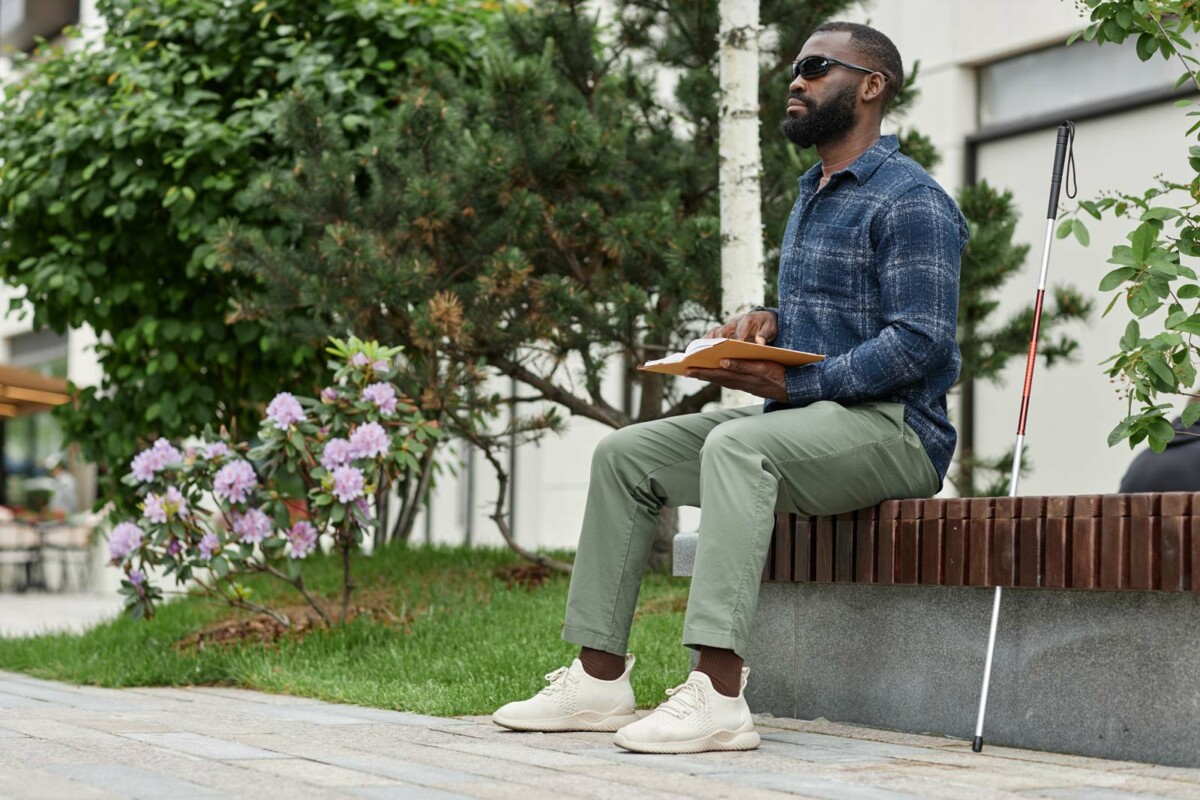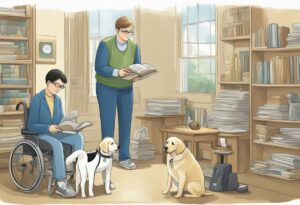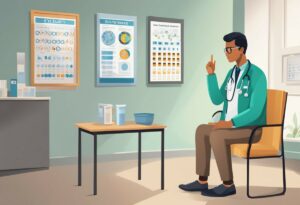Step-by-Step: Master Your New Blindness Aid with Confidence

Navigating the world with a visual impairment can be challenging, but with the right tools and techniques, individuals can maintain their independence and continue to participate in everyday activities. One such essential tool is a blindness aid. These aids come in various forms, such as white canes, guide dogs, and digital devices that assist with wayfinding and accessing information.
Adapting to a new blindness aid may take some time and practice, but knowing how to use it effectively can significantly improve one’s quality of life. This article will provide step-by-step guidance to help you master your new aid, covering proper usage and relevant techniques tailored for each type of device. Our goal is to equip you with the knowledge and confidence to make the most out of your aid and optimize your daily routines.
Understanding the importance of proper training and usage can make a world of difference for visually impaired individuals. In the following sections, we will explore various aids and strategies for tackling common obstacles faced by the visually impaired community. By following these guidelines and regularly practicing with your blindness aid, you will soon experience newfound freedom and self-sufficiency.
Understanding Blindness and Visual Impairment
Defining Blindness and Visual Impairment
Blindness and visual impairment are terms used to describe a wide range of vision-related disabilities. A person is considered blind if they have a complete or nearly complete loss of vision. Visual impairment, on the other hand, is a broader term that includes both total blindness and vision loss that can’t be corrected by glasses or contact lenses.
Various factors can cause these disabilities, such as congenital conditions, diseases, or injuries. Some of the most common causes are age-related macular degeneration, cataracts, diabetic retinopathy, and glaucoma.
It is essential to understand the different types of blindness and visual impairment for the proper use and implementation of blindness aids.
Impact on Daily Life
Living with blindness or visual impairment can pose various challenges in everyday life. Some of these challenges include:
- Mobility: Navigating through unfamiliar surroundings can be difficult for individuals with vision loss.
- Communication: Reading printed materials, using electronic devices, or recognizing facial expressions may be challenging.
- Daily tasks: Performing tasks such as cooking, cleaning, or personal grooming may require adjustments or alternative techniques.
- Education and employment: Accessing and participating in academic or professional settings usually require adaptative tools and accessibility accommodations.
To address these challenges, various blindness aids are available, each designed to cater to specific needs and improve the quality of life for those living with vision loss. Effectively using your new blindness aid starts with understanding its purpose and applying its functions to navigate through the challenges you face daily.
Types of Blindness Aids
Blindness aids play a crucial role in improving the independence and quality of life for people with visual impairments. These mobility tools help enhance their confidence and allow them to navigate through daily activities more effectively. In this section, we will discuss two primary types of blindness aids: White Cane & Guide Dog.
White Cane
The white cane is an essential mobility tool for people with visual impairments. This lightweight, collapsible stick enables individuals to detect obstacles in their path and gather information about their environment. It also serves as an identifier for others, alerting them of the user’s visual impairment.
There are three main types of white canes:
- Straight cane: A simple, rigid stick that provides basic obstacle detection.
- Folding cane: Collapsible into sections for easy storage and portability.
- Telescoping cane: Adjustable in length, allowing users to customize based on their preference.
Cane techniques may vary based on individual needs, but the common sighted guide technique involves walking one full step directly behind a sighted person, using the cane to detect obstacles.
Guide Dog
Guide dogs are specially trained animals that assist people with visual impairments in navigating their environment. They provide users not only with mobility support but also with companionship and emotional support. Acquiring a guide dog typically involves working with a dedicated organization that breeds and trains these animals for use as mobility aids.
Benefits of using guide dogs include:
- Enhanced mobility: Guide dogs help users avoid obstacles, indicating changes in elevation and guiding them around potential hazards.
- Greater independence: With a guide dog, users can rely less on human assistance for their daily activities, enabling them to move freely and confidently.
- Emotional support: Having a guide dog as a companion fosters emotional well-being for the visually impaired.
Both white canes and guide dogs serve as valuable mobility tools for people with visual impairments, enabling them to navigate their environment with increased freedom and confidence. Selecting the most appropriate aid will ultimately depend on individual preferences and needs.
Introducing and Assisting a Blind or Visually Impaired Person
Proper Etiquette
When interacting with a blind or visually impaired person, it is essential to practice proper etiquette. First and foremost, treat them normally as you would anyone else. Speak first and kindly introduce yourself to ensure they are aware of your presence. When offering a handshake, wait for the individual to extend their hand before proceeding.
During a conversation, maintain eye contact even if the person cannot see you, as this is a universal courtesy. If the visually impaired individual needs assistance, ask them if they require help and never assume their needs.
Effective Communication
Effective communication plays a vital role in interacting with a blind or visually impaired person. Here are some essential tips to follow:
- Carefully describe the situation and provide context when required, as this can help them better understand their surroundings. Inclusive City Maker suggests using clear, concise language to offer information without overwhelming the individual.
- When offering assistance, allow the person to take your arm, which is called the sighted guide technique. Extend your arm for them to hold onto just above the elbow.
- Maintain a normal pace during the conversation, avoid speaking too slowly or loudly. Respect personal space and avoid unnecessary physical contact.
- Be patient and understanding if the blind or visually impaired individual asks you to repeat or clarify information. Open communication is crucial for developing strong relationships.
By practicing proper etiquette and effective communication, you can make a positive impact on the lives of blind and visually impaired individuals, helping them to integrate seamlessly into their environment and improve their overall experience.
Sighted Guide Techniques
Proper Grip and Arm Position
When assisting a person with visual impairment, proper grip and arm positioning are crucial in ensuring their safety and comfort. The sighted guide should offer their arm, bent at the elbow, to the person who is blind. The blind person should then grip the guide’s arm, just above the elbow, with their fingers on the inside and thumb on the outside, providing a secure yet comfortable hold1.
The blind person should stand one step behind the guide, keeping their extended arm at a comfortable angle to avoid stepping on the guide’s heels2. This positioning allows for clear communication and efficient movement.
Navigating Various Situations
- Stairs: When approaching stairs, the sighted guide should pause before the first step and inform their companion whether they will be going up or down. The guide should then place their foot on the first step, signaling the start of the stairs3. The blind person should follow closely as they descend or ascend the stairs together.
- Doorways: When passing through doorways, the sighted guide should approach the door and describe its direction of opening (left or right). They should open the door with their free hand and transfer the blind person’s grip to their other forearm, guiding them through the doorway4.
- Narrow Spaces: In situations where space is limited, the sighted guide should move their guiding arm behind their back, prompting the blind person to step directly behind them and follow in single file5. Once the narrow passage is cleared, the blind person should return to their original side-by-side position.
By following these techniques, the sighted guide can efficiently and safely navigate multiple situations while ensuring a comfortable experience for the blind person.
Navigating the Environment with a Blindness Aid
Moving Through Doorways
When approaching doorways, use your blindness aid to detect any obstacles that may be in your path, such as open doors, door frames, or people. Move slowly and maintain physical contact with the wall or door frame for guidance. Once you’re at the doorway, locate the door handle using your free hand, and always ensure the door is completely open before proceeding.
Climbing Up and Down Stairs
Stairs can be challenging for individuals with vision loss, but with care and attention to technique, they can be navigated safely. Start by using your blindness aid to locate the staircase and identify whether it goes up or down. When ascending, lead with your stronger leg and use the handrail for additional support. When descending, lead with your weaker leg and continue using the handrail. Tap the tip of your aid on each step to keep track of your progress.
| Up Stairs | Down Stairs |
| Lead with stronger leg | Lead with weaker leg |
| Tap each step with aid | Tap each step with aid |
Crossing Streets and Curbs
To safely cross streets and curbs, it’s essential to use your blindness aid for detecting changes in elevation and locating pedestrian crossings. Listen for auditory cues, such as traffic signals or crossing guard instructions, and always pause before stepping off the curb. Align yourself with the direction of pedestrian traffic and use your aid to maintain a straight pathway across the street.
Finding Seating
When searching for seating in public areas, use your blindness aid to identify empty chairs and benches. Gently tap your aid on the ground and listen for the distinct sounds of an unoccupied seat. When approaching the chair, use your free hand to feel the seating surface and backrest before sitting down.
Navigating Crowded Areas
Crowded areas can be particularly challenging. Maintain a slow, deliberate pace and keep your blindness aid in front of you to detect obstacles or potential collisions. If you need assistance, don’t hesitate to ask a staff member or a fellow pedestrian for help. Listening to the sound patterns and foot traffic can also offer valuable cues on how to navigate the crowd efficiently and safely.
Resources and Support for the Blind and Visually Impaired Community
American Foundation for the Blind
The American Foundation for the Blind (AFB) is a leading organization that provides resources for adults new to vision loss. Their VisionAware initiative helps individuals losing their sight maintain independent and fulfilling lives by offering timely information and step-by-step guides for daily living. AFB is dedicated to creating a more inclusive and accessible society for people with vision loss by providing resources, tools, and support to navigate everyday life effectively.
Raising Awareness and Advocacy
Raising awareness and advocacy for the blind and visually impaired is essential in promoting equal opportunities and reducing social stigmas. One way to do this is by educating the public and encouraging a more inclusive society that caters to individuals with varying levels of vision. Guidelines for assisting the blind and visually impaired can provide essential information to understand their needs, show respect, and offer help when necessary.
Another key aspect of raising awareness is addressing barriers that hinder visually impaired people’s participation in everyday activities. For this purpose, organizations and individuals advocate for accessible public spaces, improved technology, and better services that cater to the unique needs of the blind and visually impaired community. By being informed advocates, we can work together to create more inclusive environments and improve the quality of life for those living with vision loss.
Frequently Asked Questions
What is the sighted guide technique?
The sighted guide technique is a method used to assist a blind or visually impaired person in navigating their environment. To be effective, the sighted guide and the blind person should establish proper position and communication. The blind person lightly grasps the sighted guide’s arm, just above the elbow, while walking half a step behind. This allows the blind person to feel the guide’s body movements and anticipate changes in direction or obstacles.
How can you assist a blind person in crossing the road?
When assisting a blind person in crossing the road, first ask if they need help. If they accept, allow them to grasp your arm just above the elbow. Approach the edge of the curb and verbally notify them that you are about to cross. Ensure that it is safe to cross and provide information regarding any obstacles, traffic signals, or audible cues. Maintain a comfortable pace and clear communication throughout the crossing.
Which communication methods can be used for blind people?
There are several communication methods that can be used for blind people, including:
- Braille, a tactile writing system that uses raised dots to represent letters, numbers, and symbols.
- Audio recordings or text-to-speech software.
- Adaptive technologies, such as screen readers, to make digital content accessible.
- Tactile graphics, including maps and diagrams, with raised lines and textures.
- High-contrast, large-print materials for individuals with low vision.
What are the common needs of blind individuals?
The common needs of blind individuals vary depending on their level of vision, lifestyle, and preferences. Some common needs may include:
- Orientation and mobility training to improve their ability to navigate in their environment.
- Access to assistive tools and technologies, such as white canes, guide dogs, and adaptive software.
- Understanding of available resources, rights, and legal protections.
- Inclusion and support from family, friends, and community.
How do you help a visually impaired person walk?
To help a visually impaired person walk, offer your assistance and allow them to grasp your arm just above the elbow if they accept. Walk half a step ahead, allowing the person to feel your body movements and anticipate changes in direction. Give clear verbal information about obstacles, steps, or turns in the path. Remember to maintain a comfortable pace and communicate effectively.
What is involved in a nursing care plan for a blind patient?
A nursing care plan for a blind patient should address the individual’s needs by:
- Assessing the patient’s level of vision, communication needs, and daily living skills.
- Developing patient-centered goals, such as improving independence, pain management, or rehabilitative care.
- Implementing interventions, including environmental adaptations, assistive tools, and training in adaptive techniques.
- Regularly evaluating the patient’s progress and adjusting the care plan as necessary.
Footnotes
- OBVI: Sighted Guide Techniques ↩
- Sighted Guide Techniques ↩
- Guiding the Blind or Visually Impaired: Techniques for Sighted ↩
- Sighted Guide Technique – Overview ↩
- Sighted Guide Techniques for use by Individuals who are ↩
At New England Low Vision and Blindness we are dedicated to empowering individuals who are blind by providing a wide range of assistive technology and assistive training solutions.
Our blindness products are specifically designed to enhance independence and improve the quality of life for those with visual impairments. From electronic magnifiers and screen readers to braille displays, we offer a diverse selection of tools to support daily living, communication, and mobility.
With our expertise and comprehensive range of technology and training, we strive to meet the unique needs of each individual.
Explore our blindness products at https://nelowvision.com/product-category/blindness-products/ and discover how we can help you thrive with confidence and accessibility.



